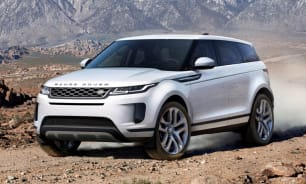On first approach, you ask yourself whether the #3 is a crossover or a small-to-medium SUV. The low roof and cool frameless doors certainly suggest the former, as do the comparatively small apertures.
That said, with the windows down, those sash-less doors help entry and egress.
Once ensconced inside a long if slightly narrow cabin, the #3 offers ample room for even the tallest adults up front, as well as a reasonably spacious back seat area, though you’d call that more of a '2+1' seater given the lack of girth for three. Most folk shouldn’t struggle to find the right driving position, either.
Presumably keen to impart a generic Mercedes vibe, the #3’s interior is somewhat reminiscent of a GLA’s, albeit from last decade – down to the pronounced T-shape dash featuring a trio of circular vents in the middle, a standalone screen above and (unconvincing) metal-look plastic trim below.
Understandably, like so much of the Brabus, this might appeal to aspiring A45 AMG owners, but it seems oddly dated, given the advanced electrification going on underneath.
Likewise, none of the minimalism cleverness of the ForTwo city-car original is referenced, even digitally. A lost opportunity, really. The OG Smart is an icon.
Meanwhile, ahead of the driver, a narrow digital strip looks twee and cheap, as if ripped from a Japanese 'Kei' car. It’s a strange design detail for a $71K SUV.
Still, the #3’s cabin layout is largely a success, and much of that is due to the first-class quality and finish. Unlike some of the aforementioned Benzes of the previous decade, squeaks and rattles are notable by their absence.
Depending on your body, the racy sports seats up front are either perfectly bolstered or far-too snug, but they provide a decent level of comfort and support. And they position you just right for controlling the centre display, which dominates all.
The 12.8-inch touchscreen feels slick, responsive and right-sized for the car. At first, it can also seem like info-overload and perhaps a bit cheesy with its animal animations, but real thought has gone into it to provide an extraordinary level of functionality.
Across the top are icons for access to media, sat-nav, apps and camera view settings, while the bottom row is for various climate and trip info. While somewhat logically presented, the charging-station list seemed outdated and/or at-times incorrect in our test car.
Mercifully, the Smart has a row of short-cut buttons for 'Vehicle Modes' (including turning off the infernal lane assist and one-pedal accelerator/braking), 'Driving Mode' ('Eco'/'Comfort'/'Sport'/'Brabus'), glass demisters, climate and display-off.
Annoyingly, the latter is closest to reach, revealing the #3’s left-hand drive market bias, as the driver must stretch across to access the first two (and more important) settings.
There are also several handy screen-activated modes including 'Entertainment Mode' that temporarily leaves the accessories and climate control on; 'Rest Mode' reclines the driver’s seat down flat and dims the interior lights; 'Energise Mode' is designed to pep you up; and 'Pet Mode' keeps a climate-controlled atmosphere while deactivating all buttons that a stray paw might press. Clever.
There’s lots more besides, and using the touchscreen is better in this than most other Chinese vehicles, but it remains fiddly and distracting.
It’s also worth pointing out that the fixed glass roof needs a blockout for Australia. A Smart spokesperson said an aftermarket cover is available, but as supplied to us, sitting under it over a run of hot days is almost unbearable without a hat. This is not good enough.
Thankfully, the other basics are all A-OK.
The climate system coped well the hot sun bearing down through the glass, plenty of useful storage makes up for the disappointingly shallow glove box, while the chilled centre console and massive door bins proved especially handy.
USB access is easy, the wireless Bluetooth/Apple CarPlay performed more consistently than in any recent test vehicle and the standard Beats audio brings brilliant sound.
Out back, most people under 180cm should at least avoid scraping that glass ceiling, and there’s a reasonable amount of room for boots and long knees if the front occupants are sympathetic, but you’d be stretching the truth calling the rear seat packaging SUV-esque.
On the other hand, it’s beautifully presented, boasts a comfy and supportive backrest/cushion for outboard passengers and even a do-able centre pew for shorter-distance riders.
And it provides every expected amenity, including air vents, USB-C ports, door storage, a folding centre armrest with cupholders, and overhead handles/lighting/coat hooks.
And while we’ve already complained about the glass roof, it floods the cabin with light, to make it seem airier than it is. Narrow front seats with a see-through slit further enhance this feeling.
Further back, the 370-litre boot is reasonably long and surprisingly deep thanks to a removable upper floor that’s good for stuffing the optional home charging cables in.
And, of course, it can be extended to 1160L via the split-fold backrests to provide extra loading practicality. And there’s even a small (15L) amount of storage under the bonnet.
Maximum towing capacity is 1600kg for a braked trailer.























.png)







.png)


.png)

.png)

.png)


.png)

.png)

.png)
.png)
.png)



.png)


.png)





.png)













































.png)
.png)













.png)

























 copy.png)








.png)










.png)

.png)


.png)












.png)


.png)








